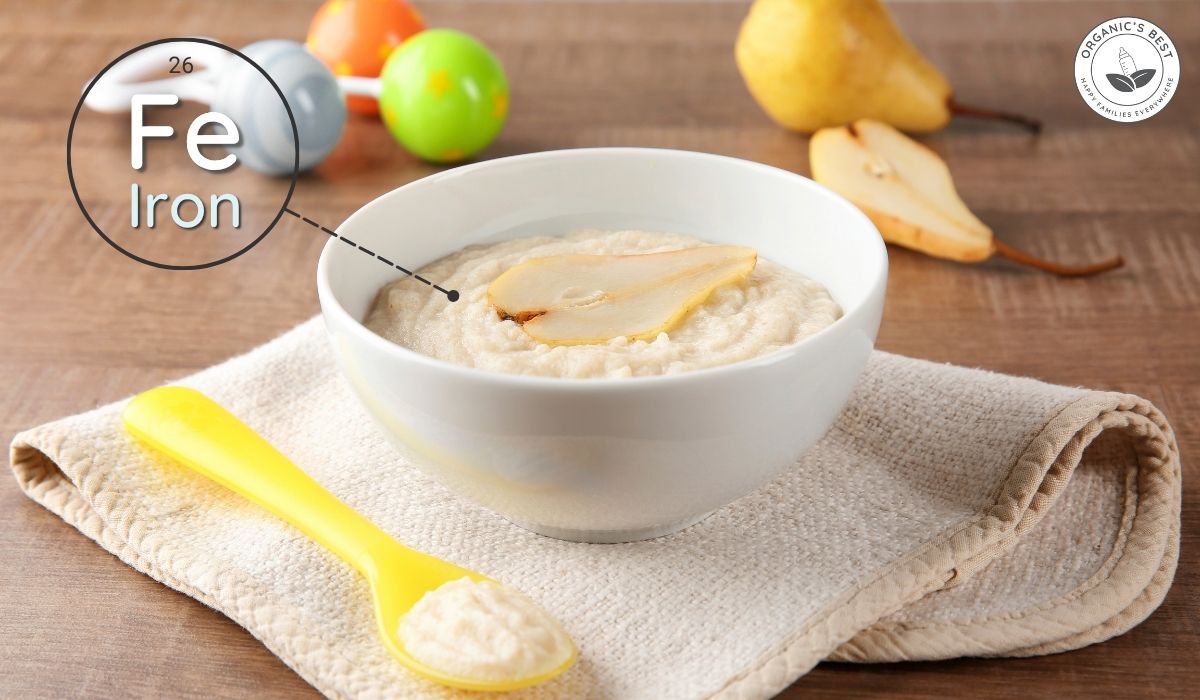Click to Get 2 FREE Boxes/Cans
Only New Customers! Click HERE to Get 2 Extra Boxes/Cans for Free With Your First Order.
BABY FORMULA
Offering new parents top-quality European infant formula from renowned brands like HiPP, Holle, Kendamil, and more. If you’re uncertain about which product to choose, our Formula Finder can help you make the best decision for your baby.
Baby Food
Offering new parents a premium selection of European baby foods, including jars, pouches, cereals, and snacks from esteemed brands like HiPP and Holle.
Health Benefits of Iron-Fortified Baby Cereal
by Agustina Fernandez January 10, 2023 6 min read

It is no doubt that being a parent is super time-consuming, and as your child transitions to solid foods, it may be beneficial to have a few healthy and convenient snacks or meal options at your disposal. One of the most popular and widely relied-on products for infants over 6 months is baby cereal.
Despite it being a convenient, store-bought item, it is an overall healthy product and the best baby cereal is often fortified with beneficial ingredients, that support your baby's health and well-being, such as Iron.
Below we will discuss the benefits of iron-fortified baby cereal, along with product recommendations and tips for introducing new food to your baby's diet.
Table of contents
Why Are Many Cereals Fortified With Iron?

There are many reasons why certain food goes through the fortification process, especially when it is specifically made for infants, whose growing bodies need certain amounts of macronutrients and micronutrients to thrive.
Fortification involves the deliberate increase of a specific (or multiple) micronutrient(s), which consequently improves the nutritional quality. Food fortification can be done to cater to the needs of a certain demographic (ie. infants), increase the overall nutritional content of popular foods, or in order to replenish micronutrients lost during processing.
This long-standing custom has been a great tool used in public health practices, as fortified foods have been shown to significantly decrease certain micronutrient deficiencies.
There are many benefits of iron, which is a mineral that supports a child's growth and development. To be more specific, iron supports childhood learning and helps disperse oxygen throughout the body. Baby cereal is often fortified with iron due to the risks associated with not receiving enough iron, such as iron deficiency anemia.
Is Iron-Fortified Cereal Good For Babies?
 Iron-fortified baby cereals are a great source of nutrition starting at 6 months when your child begins the transition from breast milk or formula to solid foods. When choosing a specific cereal, there are a few factors to consider.
Iron-fortified baby cereals are a great source of nutrition starting at 6 months when your child begins the transition from breast milk or formula to solid foods. When choosing a specific cereal, there are a few factors to consider.
-
Choose unsweetened iron-fortified cereals instead of ready-to-eat cereals.
-
Begin with a single-grain cereal when introducing your child to iron-fortified cereals, such as oatmeal, barley, wheat, or baby rice cereal.
-
It is recommended to wait 3-5 days before adding another new food to your baby's diet, whenever you start introducing them to new foods, including baby cereal, as this allows you time to monitor for symptoms of a food allergy.
-
Later you can begin to offer infant cereal made with multiple grains once your baby is accustomed to one grain, and they are showing no signs of a food allergy.
What Cereals Are Fortified With Iron?
Organic's Best carries a range of healthy and yummy organic baby cereal. Here are 4 of HiPP's best baby cereals that are fortified with iron.
HiPP Organic Good Night Milk Porridge (Oat and Apple)
 This milk porridge made with whole grain cereals and organic fruits is gentle on a baby's tummy and free from added sugar.
This milk porridge made with whole grain cereals and organic fruits is gentle on a baby's tummy and free from added sugar.
It is fortified with iron, while also containing other beneficial nutrients such as iodine, calcium, and Omega-3 fatty acids.
HiPP Organic Banana-Semolina Milk Evening Porridge
This milk porridge is super easy to make, requiring just the product itself along with some water.
It is made with whole grain cereals and organic bananas along with beneficial nutrients such as iron, iodine, calcium, and Omega-3 fatty acids.
Just like many other HiPP baby food products, this porridge is free from added sugar and gentle on a baby's tummy.
HiPP Organic Good Night Milk Porridge - Biscuit
This milk porridge is gently processed and free from added sugar, meaning that no ingredients such as granulated sugar, fructose, or syrups have been added.
It is made with organic whole grains and is rich in iron, iodine, calcium, and Omega-3 fatty acids.
HiPP Organic Semolina Milk Porridge
This milk porridge is unsweetened and made with strictly selected organic ingredients. It is fortified with vitamins and minerals tailored to meet babies' special nutritional needs.
This product is rich in iron, iodine, and calcium and can be easily prepared using freshly boiled water.
How Long Should Babies Eat Iron-Fortified Cereal?
There is no limit to how long a baby can enjoy iron-fortified baby cereals, although it is important that their diet also includes other sources of iron. Once your baby starts transitioning to solid food, at around 6 months, there are a ton of iron-rich foods to introduce to their diet, alongside baby cereal.
Learn More: How to Make Baby Oatmeal With Formula?
There are two types of iron found in foods, which are heme and non-heme iron. The difference between the two is in how easily the iron is absorbed by the body.
Because non-heme iron is less easily absorbed, it is important to monitor how much of these items your little one is eating, compared to items that contain heme iron.
At around the 12-month mark, your child will likely be screened for anemia, but if you are concerned at all about your child's iron intake before that time, it is best to consult your pediatrician.
Let's take a look at which common food items contain heme iron vs non-heme iron...

Heme iron can primarily be found in animal products. These items include:
- Red meat
- Seafood
- Poultry
- Eggs
Non-heme iron is primarily present in plants and iron-fortified products. These items include:
- Iron-fortified infant cereals
- Tofu
- Beans and lentils
- Dark green leafy vegetables
It is beneficial to eat non-heme items with foods rich in vitamin C because pairing the nutrients together can aid in the absorption of iron. Some foods rich in vitamin C include the following:
- Citrus fruits like oranges
- Berries
- Papaya
- Tomatoes
- Sweet potatoes
- Broccoli
- Cabbage
- Dark green leafy vegetables
What Should Parents Look For in a Cereal?
The main component of baby cereal to focus on is the ingredients. Ideally, the baby cereal that you choose should have limited ingredients consisting mainly of grains alongside any vitamins and minerals used to enrich the product.
Choosing an organic product such as an organic infant rice cereal or organic whole grain oats cereal comes with added health benefits.
Learn More: Different Levels Of Organic Certification In Europe
It is also beneficial to choose a cereal with whole grains listed as one of the first ingredients, and if sugars are included they should be further down the ingredients list, but ideally, it is best if the baby cereal is completely free from added sugar.

To put it simply, when choosing baby cereals follow these guidelines:
-
Cereal should be free from added sugars
-
Contains a small list of healthy ingredients
-
Ingredients should consist of grains alongside vitamins and minerals
-
Choose organic when possible
-
Grains should be listed as a top ingredient
Learn More: Best Organic Baby Cereal
Are Some Baby Cereals Dangerous?
There has been some controversy surrounding rice cereal for a couple of reasons. The first reason being for the amount of arsenic it contains, which could be dangerous in large quantities, and the second reason being rice cereal is more likely to cause constipation compared to other types of baby cereal.
Despite these claims, rice cereal can still be a healthy part of your baby's diet, it just shouldn't be relied on as a main source of iron. When given the choice, it may be beneficial to choose a cereal made from a different grain such as oat, barley, or whole wheat, instead of rice.
Conclusion
Including baby cereals enriched with iron in your little one's diet can be hugely beneficial, but should not be used to replace other sources of iron.
It is always best to offer your baby a diet with plenty of variety to help them obtain all of the different types of nutrients their body needs for growth and development.
Iron-rich foods can prevent anemia while supporting your baby's overall health and should be given to your little one from the 6-month mark.
|
Disclaimer: Please be aware that this information is based on general trends in babies, and it is not medical advice. Your doctor should be your first source of information and advice when considering any changes to your child’s formula and when choosing your child’s formula. Always consult your pediatrician before making any decisions about your child’s diet or if you notice any changes in your child. Breastfeeding is the best nutrition for your baby because breast milk provides your child with all the essential nutrients they need for growth and development. Please consult your pediatrician if your child requires supplemental feeding. |
Agustina Fernandez
Dr. Agustina Fernandez earned her medical degree from the prestigious Universidad Nacional de Córdoba, Argentina. With a deep-rooted passion for pediatrics, Dr. Fernandez is currently on the path to specializing in children's healthcare. Recently, she has delved into the vital field of infant nutrition. Her research interests include breastfeeding, infant formula, and baby food in little ones’ formative years. Dr. Fernandez's commitment to this area of study underscores her dedication to ensuring the health and well-being of children from their earliest days.
Leave a comment
Comments will be approved before showing up.
Also in Organic Infant Nutrition and Health Blog

10 Winter Activities for Kids and Toddlers
by Agustina Fernandez January 06, 2026 8 min read
Read More
How to Choose The Best Infant Formula: A Guide to EU Organic Formulas
by Agustina Fernandez January 05, 2026 14 min read
Read More
Best Formula for Breastfed Babies 2026 Guide
by Agustina Fernandez January 05, 2026 15 min read
Read More
Reviewed by Dr. Po-Chang Hsu, MD, MS
-

Dr. Po-Chang Hsu: Medical Reviewer of Organic's Best Blog
Dr. Hsu received his medical degree from Tufts University in Boston, Massachusetts, and holds a Master’s of Science degree from both Harvard University and Tufts University.



